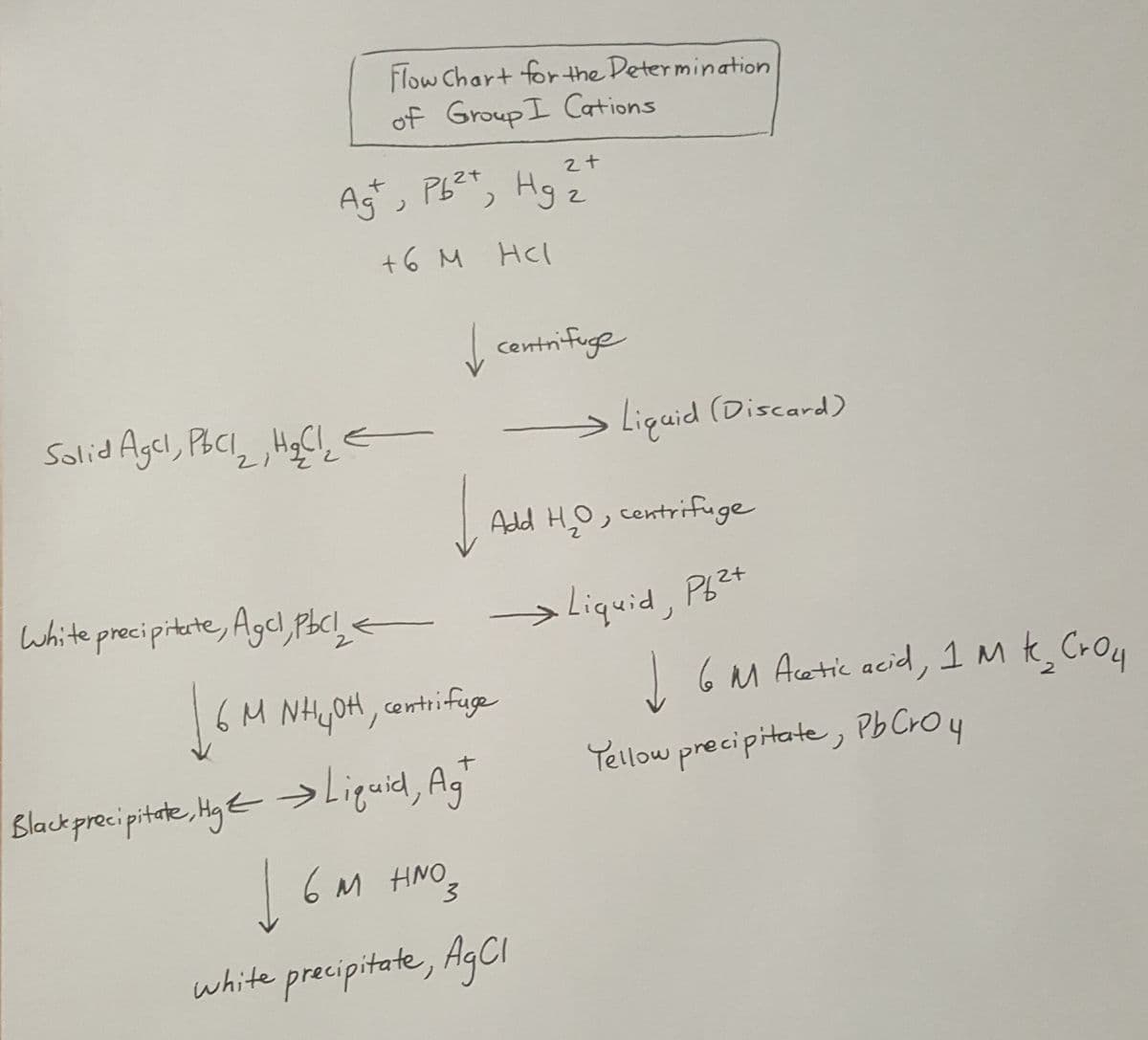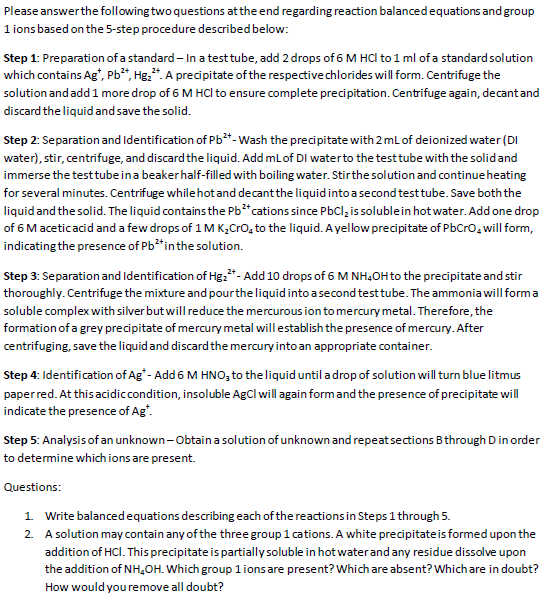Write balanced equations describing each of the reactions in Steps1 through 5. A solution may contain any of the three group 1 cations. A white precipitateis formed upon the addition of HCI. This precipitate is partially soluble in hot waterand any residue dissolve upon the addition of NH,OH. Which group 1 ions are present? Which are absent? Which are in doubt? How would you remove all doubt?
Write balanced equations describing each of the reactions in Steps1 through 5. A solution may contain any of the three group 1 cations. A white precipitateis formed upon the addition of HCI. This precipitate is partially soluble in hot waterand any residue dissolve upon the addition of NH,OH. Which group 1 ions are present? Which are absent? Which are in doubt? How would you remove all doubt?
Chemistry: Principles and Practice
3rd Edition
ISBN:9780534420123
Author:Daniel L. Reger, Scott R. Goode, David W. Ball, Edward Mercer
Publisher:Daniel L. Reger, Scott R. Goode, David W. Ball, Edward Mercer
Chapter14: Chemical Equilibrium
Section: Chapter Questions
Problem 14.97QE: According to the Resource Conservation and Recovery Act (RCRA), waste material is classified as...
Related questions
Question
Hello !
Could someone please give ideas on how to answer these 2 questions?
The questions are located on the first of the attached images. Thanks!
The Group 1 cations , Pb2+, Ag+, and Hg22+, form insoluble chlorides.
I think perhaps for q 1, what happens in each chemical individual equation when HCl is added to each cation

Transcribed Image Text:Flow Chart forthe Determination
of GroupI Cations
Ast, PB", Hg z
+6 M Hcl
I centrifuge
HgClz
Solid Agel, PbCI,
12,
, HgCI,
Liguid (Discard)
Add HO, centrifuge
white precipitete, Agel, PbCl <
>Liquid, Pbt
1 6M Acetic acid, 1 M k, Croy
2.
16M NHyoH, contrifuge
Tellow precipitate, Pb Cro y
Black precipitate, HyE Liguid, Ag"
6 M HINO3
white precipitate, H9CI

Transcribed Image Text:Please answerthe following two questions atthe end regarding reaction balanced equations and group
1 ions based on the 5-step procedure described below:
Step 1: Preparation of a standard - In a test tube, add 2 drops of 6 M HCl to 1 ml of a standardsolution
which contains Ag", Pb*, Hg.*. A precipitate of the respective chlorides will form. Centrifuge the
solution and add 1 more drop of 6 M HCl to ensure complete precipitation. Centrifuge again, decant and
discard the liquid and save the solid.
Step 2: Separation and Identification of Pb*- Wash the precipitate with 2 ml of deionized water (DI
water), stir, centrifuge, and discard the liquid. Add mlof DI waterto the testtube with the solidand
immerse the testtubeina beaker half-filled with boiling water. Stirthe solution and continueheating
for several minutes. Centrifuge while hot and decant the liquid into a second testtube. Save both the
liquid and the solid. The liquid contains the Pb*cations since PbCl, is solublein hot water. Add one drop
of 6 M aceticacid and a few drops of 1 M K¿Cro, to the liquid. A yellow precipitate of PbCro, will form,
indicating the presence of Pb*inthe solution.
Step 3: Separation and Identification of Hg.*- Add 10 drops of 6 M NH,OH to the precipitate and stir
thoroughly. Centrifuge the mixture and pourthe liquid into a second test tube. The ammonia will forma
soluble complex with silver but will reduce the mercurous ion tomercury metal. Therefore, the
formation of a grey precipitate of mercury metal willestablish the presence of mercury. After
centrifuging, save the liquidand discard the mercury into an appropriate container.
Step 4: Identification of Ag*- Add 6 M HNO, to the liquid until a drop of solution will turn blue litmus
paperred. At this acidiccondition, insoluble AgCl will again form and the presence of precipitate will
indicate the presence of Ag".
Step 5: Analysis of an unknown-Obtaina solution of unknown and repeat sections B through D in order
to detemine which ions are present.
Questions:
1. Write balanced equations describing each of the reactions in Steps 1 through 5.
2. A solution may contain any of the three group 1 cations. A white precipitateis formed upon the
addition of HCI. This precipitate is partiallysoluble in hot waterandany residue dissolve upon
the addition of NH,OH. Which group 1ions are present? Which are absent? Which are in doubt?
How would youremove all doubt?
Expert Solution
This question has been solved!
Explore an expertly crafted, step-by-step solution for a thorough understanding of key concepts.
This is a popular solution!
Trending now
This is a popular solution!
Step by step
Solved in 3 steps

Knowledge Booster
Learn more about
Need a deep-dive on the concept behind this application? Look no further. Learn more about this topic, chemistry and related others by exploring similar questions and additional content below.Recommended textbooks for you

Chemistry: Principles and Practice
Chemistry
ISBN:
9780534420123
Author:
Daniel L. Reger, Scott R. Goode, David W. Ball, Edward Mercer
Publisher:
Cengage Learning

Principles of Modern Chemistry
Chemistry
ISBN:
9781305079113
Author:
David W. Oxtoby, H. Pat Gillis, Laurie J. Butler
Publisher:
Cengage Learning

Introductory Chemistry: A Foundation
Chemistry
ISBN:
9781337399425
Author:
Steven S. Zumdahl, Donald J. DeCoste
Publisher:
Cengage Learning

Chemistry: Principles and Practice
Chemistry
ISBN:
9780534420123
Author:
Daniel L. Reger, Scott R. Goode, David W. Ball, Edward Mercer
Publisher:
Cengage Learning

Principles of Modern Chemistry
Chemistry
ISBN:
9781305079113
Author:
David W. Oxtoby, H. Pat Gillis, Laurie J. Butler
Publisher:
Cengage Learning

Introductory Chemistry: A Foundation
Chemistry
ISBN:
9781337399425
Author:
Steven S. Zumdahl, Donald J. DeCoste
Publisher:
Cengage Learning

Chemistry
Chemistry
ISBN:
9781305957404
Author:
Steven S. Zumdahl, Susan A. Zumdahl, Donald J. DeCoste
Publisher:
Cengage Learning

Chemistry: An Atoms First Approach
Chemistry
ISBN:
9781305079243
Author:
Steven S. Zumdahl, Susan A. Zumdahl
Publisher:
Cengage Learning
